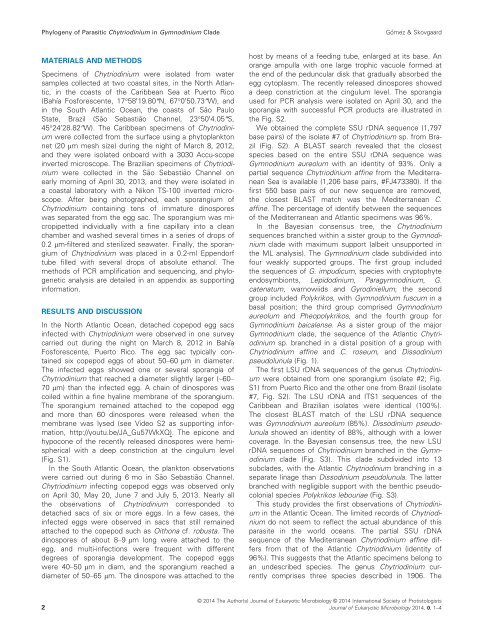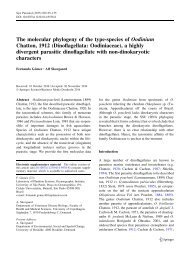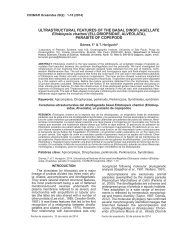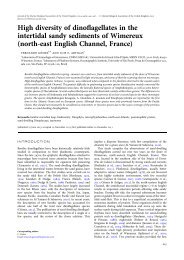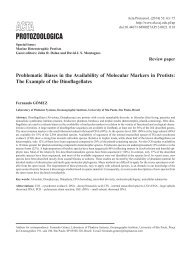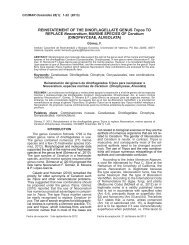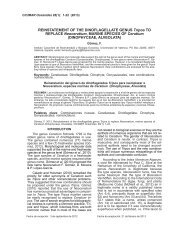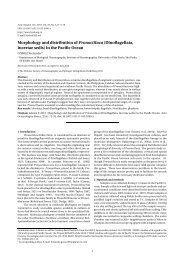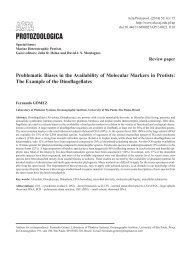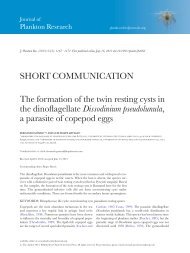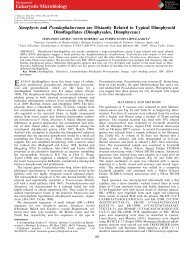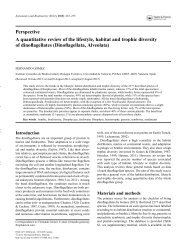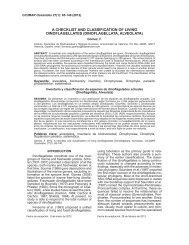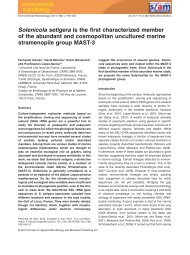Molecular Phylogeny of the Parasitic Dinoflagellate Chytriodinium within the Gymnodinium Clade (Gymnodiniales, Dinophyceae)
The dinoflagellate genus Chytriodinium, an ectoparasite of copepod eggs, is reported for the first time in the North and South Atlantic Oceans. We provide the first large subunit rDNA (LSU rDNA) and Internal Transcribed Spacer 1 (ITS1) sequences, which were identical in both hemispheres for the Atlantic Chytriodinium sp. The first complete small subunit ribosomal DNA (SSU rDNA) of the Atlantic Chytriodinium sp. suggests that the specimens belong to an undescribed species. This is the first evidence of the split of the Gymnodinium clade: one for the parasitic forms of Chytriodiniaceae (Chytriodinium, Dissodinium), and other clade for the free-living species.
The dinoflagellate genus Chytriodinium, an ectoparasite of copepod eggs, is
reported for the first time in the North and South Atlantic Oceans. We provide
the first large subunit rDNA (LSU rDNA) and Internal Transcribed Spacer 1
(ITS1) sequences, which were identical in both hemispheres for the Atlantic
Chytriodinium sp. The first complete small subunit ribosomal DNA (SSU rDNA)
of the Atlantic Chytriodinium sp. suggests that the specimens belong to an
undescribed species. This is the first evidence of the split of the Gymnodinium
clade: one for the parasitic forms of Chytriodiniaceae (Chytriodinium, Dissodinium),
and other clade for the free-living species.
You also want an ePaper? Increase the reach of your titles
YUMPU automatically turns print PDFs into web optimized ePapers that Google loves.
<strong>Phylogeny</strong> <strong>of</strong> <strong>Parasitic</strong> <strong>Chytriodinium</strong> in <strong>Gymnodinium</strong> <strong>Clade</strong><br />
Gomez & Skovgaard<br />
MATERIALS AND METHODS<br />
Specimens <strong>of</strong> <strong>Chytriodinium</strong> were isolated from water<br />
samples collected at two coastal sites, in <strong>the</strong> North Atlantic,<br />
in <strong>the</strong> coasts <strong>of</strong> <strong>the</strong> Caribbean Sea at Puerto Rico<br />
(Bahıa Fosforescente, 17°58 0 19.80″N, 67°0 0 50.73″W), and<br />
in <strong>the</strong> South Atlantic Ocean, <strong>the</strong> coasts <strong>of</strong> S~ao Paulo<br />
State, Brazil (S~ao Sebasti~ao Channel, 23°50 0 4.05″S,<br />
45°24 0 28.82″W). The Caribbean specimens <strong>of</strong> <strong>Chytriodinium</strong><br />
were collected from <strong>the</strong> surface using a phytoplankton<br />
net (20 lm mesh size) during <strong>the</strong> night <strong>of</strong> March 8, 2012,<br />
and <strong>the</strong>y were isolated onboard with a 3030 Accu-scope<br />
inverted microscope. The Brazilian specimens <strong>of</strong> <strong>Chytriodinium</strong><br />
were collected in <strong>the</strong> S~ao Sebasti~ao Channel on<br />
early morning <strong>of</strong> April 30, 2013, and <strong>the</strong>y were isolated in<br />
a coastal laboratory with a Nikon TS-100 inverted microscope.<br />
After being photographed, each sporangium <strong>of</strong><br />
<strong>Chytriodinium</strong> containing tens <strong>of</strong> immature dinospores<br />
was separated from <strong>the</strong> egg sac. The sporangium was micropipetted<br />
individually with a fine capillary into a clean<br />
chamber and washed several times in a series <strong>of</strong> drops <strong>of</strong><br />
0.2 lm-filtered and sterilized seawater. Finally, <strong>the</strong> sporangium<br />
<strong>of</strong> <strong>Chytriodinium</strong> was placed in a 0.2-ml Eppendorf<br />
tube filled with several drops <strong>of</strong> absolute ethanol. The<br />
methods <strong>of</strong> PCR amplification and sequencing, and phylogenetic<br />
analysis are detailed in an appendix as supporting<br />
information.<br />
RESULTS AND DISCUSSION<br />
In <strong>the</strong> North Atlantic Ocean, detached copepod egg sacs<br />
infected with <strong>Chytriodinium</strong> were observed in one survey<br />
carried out during <strong>the</strong> night on March 8, 2012 in Bahıa<br />
Fosforescente, Puerto Rico. The egg sac typically contained<br />
six copepod eggs <strong>of</strong> about 50–60 lm in diameter.<br />
The infected eggs showed one or several sporangia <strong>of</strong><br />
<strong>Chytriodinium</strong> that reached a diameter slightly larger (~60–<br />
70 lm) than <strong>the</strong> infected egg. A chain <strong>of</strong> dinospores was<br />
coiled <strong>within</strong> a fine hyaline membrane <strong>of</strong> <strong>the</strong> sporangium.<br />
The sporangium remained attached to <strong>the</strong> copepod egg<br />
and more than 60 dinospores were released when <strong>the</strong><br />
membrane was lysed (see Video S2 as supporting information,<br />
http://youtu.be/JA_Gu57WkXQ). The epicone and<br />
hypocone <strong>of</strong> <strong>the</strong> recently released dinospores were hemispherical<br />
with a deep constriction at <strong>the</strong> cingulum level<br />
(Fig. S1).<br />
In <strong>the</strong> South Atlantic Ocean, <strong>the</strong> plankton observations<br />
were carried out during 6 mo in S~ao Sebasti~ao Channel.<br />
<strong>Chytriodinium</strong> infecting copepod eggs was observed only<br />
on April 30, May 20, June 7 and July 5, 2013. Nearly all<br />
<strong>the</strong> observations <strong>of</strong> <strong>Chytriodinium</strong> corresponded to<br />
detached sacs <strong>of</strong> six or more eggs. In a few cases, <strong>the</strong><br />
infected eggs were observed in sacs that still remained<br />
attached to <strong>the</strong> copepod such as Oithona cf. robusta. The<br />
dinospores <strong>of</strong> about 8–9 lm long were attached to <strong>the</strong><br />
egg, and multi-infections were frequent with different<br />
degrees <strong>of</strong> sporangia development. The copepod eggs<br />
were 40–50 lm in diam, and <strong>the</strong> sporangium reached a<br />
diameter <strong>of</strong> 50–65 lm. The dinospore was attached to <strong>the</strong><br />
host by means <strong>of</strong> a feeding tube, enlarged at its base. An<br />
orange ampulla with one large trophic vacuole formed at<br />
<strong>the</strong> end <strong>of</strong> <strong>the</strong> peduncular disk that gradually absorbed <strong>the</strong><br />
egg cytoplasm. The recently released dinospores showed<br />
a deep constriction at <strong>the</strong> cingulum level. The sporangia<br />
used for PCR analysis were isolated on April 30, and <strong>the</strong><br />
sporangia with successful PCR products are illustrated in<br />
<strong>the</strong> Fig. S2.<br />
We obtained <strong>the</strong> complete SSU rDNA sequence (1,797<br />
base pairs) <strong>of</strong> <strong>the</strong> isolate #7 <strong>of</strong> <strong>Chytriodinium</strong> sp. from Brazil<br />
(Fig. S2). A BLAST search revealed that <strong>the</strong> closest<br />
species based on <strong>the</strong> entire SSU rDNA sequence was<br />
<strong>Gymnodinium</strong> aureolum with an identity <strong>of</strong> 93%. Only a<br />
partial sequence <strong>Chytriodinium</strong> affine from <strong>the</strong> Mediterranean<br />
Sea is available (1,206 base pairs, #FJ473380). If <strong>the</strong><br />
first 550 base pairs <strong>of</strong> our new sequence are removed,<br />
<strong>the</strong> closest BLAST match was <strong>the</strong> Mediterranean C.<br />
affine. The percentage <strong>of</strong> identify between <strong>the</strong> sequences<br />
<strong>of</strong> <strong>the</strong> Mediterranean and Atlantic specimens was 96%.<br />
In <strong>the</strong> Bayesian consensus tree, <strong>the</strong> <strong>Chytriodinium</strong><br />
sequences branched <strong>within</strong> a sister group to <strong>the</strong> <strong>Gymnodinium</strong><br />
clade with maximum support (albeit unsupported in<br />
<strong>the</strong> ML analysis). The <strong>Gymnodinium</strong> clade subdivided into<br />
four weakly supported groups. The first group included<br />
<strong>the</strong> sequences <strong>of</strong> G. impudicum, species with cryptophyte<br />
endosymbionts, Lepidodinium, Paragymnodinium, G.<br />
catenatum, warnowiids and Gyrodiniellum; <strong>the</strong> second<br />
group included Polykrikos, with <strong>Gymnodinium</strong> fuscum in a<br />
basal position; <strong>the</strong> third group comprised <strong>Gymnodinium</strong><br />
aureolum and Pheopolykrikos, and <strong>the</strong> fourth group for<br />
<strong>Gymnodinium</strong> baicalense. As a sister group <strong>of</strong> <strong>the</strong> major<br />
<strong>Gymnodinium</strong> clade, <strong>the</strong> sequence <strong>of</strong> <strong>the</strong> Atlantic <strong>Chytriodinium</strong><br />
sp. branched in a distal position <strong>of</strong> a group with<br />
<strong>Chytriodinium</strong> affine and C. roseum, and Dissodinium<br />
pseudolunula (Fig. 1).<br />
The first LSU rDNA sequences <strong>of</strong> <strong>the</strong> genus <strong>Chytriodinium</strong><br />
were obtained from one sporangium (isolate #2; Fig.<br />
S1) from Puerto Rico and <strong>the</strong> o<strong>the</strong>r one from Brazil (isolate<br />
#7, Fig. S2). The LSU rDNA and ITS1 sequences <strong>of</strong> <strong>the</strong><br />
Caribbean and Brazilian isolates were identical (100%).<br />
The closest BLAST match <strong>of</strong> <strong>the</strong> LSU rDNA sequence<br />
was <strong>Gymnodinium</strong> aureolum (85%). Dissodinium pseudolunula<br />
showed an identity <strong>of</strong> 88%, although with a lower<br />
coverage. In <strong>the</strong> Bayesian consensus tree, <strong>the</strong> new LSU<br />
rDNA sequences <strong>of</strong> <strong>Chytriodinium</strong> branched in <strong>the</strong> <strong>Gymnodinium</strong><br />
clade (Fig. S3). This clade subdivided into 13<br />
subclades, with <strong>the</strong> Atlantic <strong>Chytriodinium</strong> branching in a<br />
separate linage than Dissodinium pseudolunula. The latter<br />
branched with negligible support with <strong>the</strong> benthic pseudocolonial<br />
species Polykrikos lebouriae (Fig. S3).<br />
This study provides <strong>the</strong> first observations <strong>of</strong> <strong>Chytriodinium</strong><br />
in <strong>the</strong> Atlantic Ocean. The limited records <strong>of</strong> <strong>Chytriodinium</strong><br />
do not seem to reflect <strong>the</strong> actual abundance <strong>of</strong> this<br />
parasite in <strong>the</strong> world oceans. The partial SSU rDNA<br />
sequence <strong>of</strong> <strong>the</strong> Mediterranean <strong>Chytriodinium</strong> affine differs<br />
from that <strong>of</strong> <strong>the</strong> Atlantic <strong>Chytriodinium</strong> (identity <strong>of</strong><br />
96%). This suggests that <strong>the</strong> Atlantic specimens belong to<br />
an undescribed species. The genus <strong>Chytriodinium</strong> currently<br />
comprises three species described in 1906. The<br />
2<br />
© 2014 The Author(s) Journal <strong>of</strong> Eukaryotic Microbiology © 2014 International Society <strong>of</strong> Protistologists<br />
Journal <strong>of</strong> Eukaryotic Microbiology 2014, 0, 1–4


